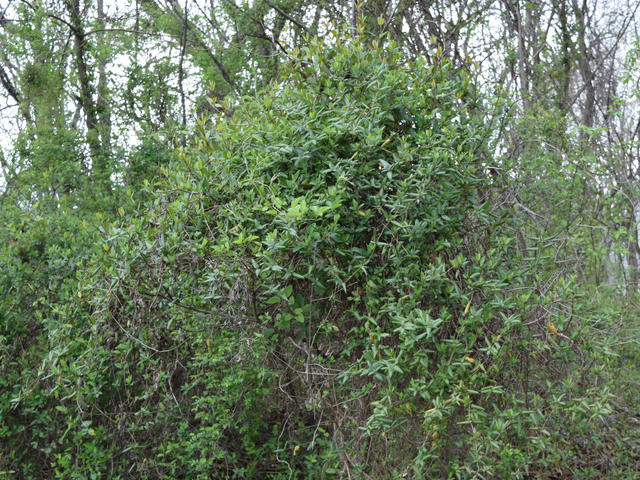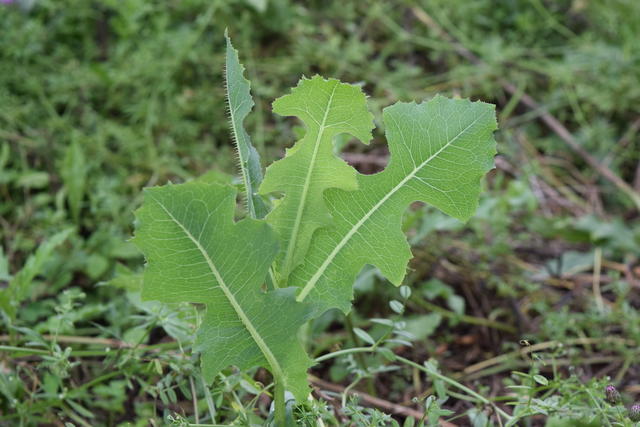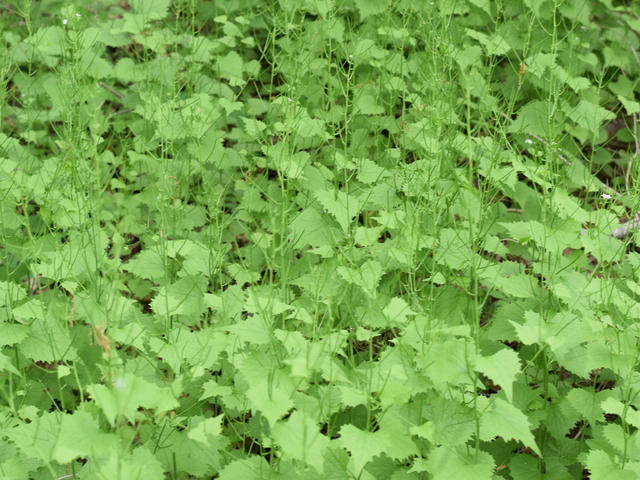A Control Section for Invasive Plants
April 15th, 2021 by Alex Zorach
Up until now, our plant articles have been purely descriptive, focusing on ecological aspects like habitat, faunal associations, life cycle, genetic relationships to other plants, and also on identification. However, the ultimate purpose of our site is to preserve, protect, and restore biodiversity through education and information.Invasive plants represent a major threat to biodiversity because of their potential to disrupt ecosystems, outcompeting native plants and often supporting fewer native insects. But attempts to control invasive plants are often limited by knowledge. Attempts to remove a species without understanding its ecology, at best can waste resources and be ineffective, and at worst can actively damage the environment in multiple ways. But a well-informed effort can often achieve large results with minimal effort.
 Japanese honeysuckle (Lonicera japonica) smothering trees in edge habitat. This plant is often hard to completely remove, but minimal effort can reduce its extent and prevent it from going to seed.
Japanese honeysuckle (Lonicera japonica) smothering trees in edge habitat. This plant is often hard to completely remove, but minimal effort can reduce its extent and prevent it from going to seed.To address these concerns, we have added a control section to the articles for plants invasive in North America. We hope this section can help people and organizations use their limited resources effectively, maximizing their benefit and minimizing effort and cost, and of course, avoiding unintentional harm.
How can control attempts fail or backfire
Here are some of the more common ways that invasive plant control can go wrong:- Removal of annual or biennial plants after seed has been produced and dispersed. In this case, uprooting, cutting/mowing, or spraying herbicide on plants may have no benefit at all, and in some cases may actively facilitate the spread of the plant's seeds.
- Lack of follow-up. Most invasive species are resilient and will resprout or re-establish after a control attempt. For example, garlic mustard (Alliaria petiolata) usually requires at least two years of removing all flowering plants in order to see a major reduction of its numbers, and at least 5 years of follow-up to fully remove it from an area, due to its persistence in the seed bank. A one-time effort or even repeated efforts with insufficient follow-up may have little benefit in the long-run.
- Unintentionally spreading invasive plants. Such spread can occur by transporting seed, stem, or roots to a new location while removing a plant from a site. This problem can occur when removing plants that have already produced seed, and also with removing roots or rhizomes of plants such as Japanese knotweed (Polygonum cuspidatum) or creeping thistle (Cirsium arvense) that are able to reproduce vegetatively through underground rhizomes or root fragments. Non-target invasive plants can also be spread if you remove soil containing seed or roots and move it to a new area.
- Herbicide use without follow-up to remove resistant plants. Failing to return to identify and remove resistant plants can contribute to the evolution of herbicide resistance. If any resistant plants survive, subsequent attempts to control the plant by the same method will be less successful. Once plants adapt to an herbicide, their resistance can spread to other populations, which is why most plants that are common agricultural weeds have already evolved herbicide resistance.
- Killing non-target plants. This problem is most common when herbicide is applied to an area where an invasive plant is growing together with native plants, but can occur with other control methods too, such as if uprooting, clipping, or mowing an invasive plant kills or damages native plants growing together with it. In many cases, killing non-target plants can worsen the infestation of an invasive plant by removing native plants that were competing with it.
- Disturbance allowing the establishment of new invasive plants or re-establishment of the original target plant. This problem frequently occurs with soil disturbance from tilling soil or uprooting plants, it and can also result from the blanket killing of vegetation by herbicide, mowing, or other methods.
- Control where control is not necessary or beneficial. Just because a particular plant is invasive in North America doesn't mean it makes sense to control it in all cases. Some plants are only invasive in some parts of the country, like how European holly (Ilex aquifolium) is invasive in the Pacific Northwest, but not in the eastern U.S. Other plants, such as white clover (Trifolium repens), are introduced and widespread, but mostly survive in areas around humans and rarely pose a problem to wild ecosystems. Even with plants that are locally invasive, there may be little benefit and/or high costs to controlling it on certain sites, such as on isolated sites with few or no native plants.
 Prickly lettuce (Lactuca serriola) is often favored by ill-conceived control attempts of other species. It is resistant to most herbicides, but has high light needs, and thus herbicide application in an area tends to favor its establishment or survival by preferentially killing competing vegetation. This individual is growing in an area between railroad tracks and a parking lot, where herbicide is frequently sprayed. Prickly lettuce is best pulled by hand early in its life-cycle, or cut to the ground right as it begins to bloom.
Prickly lettuce (Lactuca serriola) is often favored by ill-conceived control attempts of other species. It is resistant to most herbicides, but has high light needs, and thus herbicide application in an area tends to favor its establishment or survival by preferentially killing competing vegetation. This individual is growing in an area between railroad tracks and a parking lot, where herbicide is frequently sprayed. Prickly lettuce is best pulled by hand early in its life-cycle, or cut to the ground right as it begins to bloom.Our control sections take all of these things into account in recommending which approaches to use in which circumstances, and we explicitly warn the reader about the most common dangers in trying to remove a particular species by a particular method.
Resources are limited and efficiency matters.
Invasive plant control is a difficult and often resource-intensive effort, requiring time and exertion, tools, and other supplies. In most cases it is not realistic to completely remove an invasive species from a location, and even when it is possible to remove some specific species, land managers must often pick and choose their battles, making a complex cost-benefit analysis to decide which species are worth the effort.Using resources more efficiently means you can successfully carry out more of these battles, making sure your efforts have the maximum effect for protecting and restoring native plant populations.
 Timing is critical in invasive plant control. Here a large monoculture of garlic mustard (Alliaria petiolata) has already begun forming seeds. It is easier to control this plant earlier in the season before seeds have formed, as pulled plants can be left in place to die; now extra work must be done to remove the seeds and care must be taken to avoid spreading them to new habitats. Later, once seed is dispersed, it will not be possible to control this generation of plants at all.
Timing is critical in invasive plant control. Here a large monoculture of garlic mustard (Alliaria petiolata) has already begun forming seeds. It is easier to control this plant earlier in the season before seeds have formed, as pulled plants can be left in place to die; now extra work must be done to remove the seeds and care must be taken to avoid spreading them to new habitats. Later, once seed is dispersed, it will not be possible to control this generation of plants at all.By better understanding the life-cycle, growth habit and physical structure of each species, as well as its unique adaptations to its environment and limitations, you can avoid unnecessary work. You can also better choose which plants to tackle along with where and when to do it. We hope our new control section will provide exactly this information.
Take a Peek
Here is a sampling of our published articles on invasive or introduced plants, where we have added a control section:- Norway Maple (Acer platanoides)
- Garlic Mustard (Alliaria petiolata)
- Bishop's Goutweed (Aegopodium podagraria)
- Poison Hemlock (Conium maculatum)
- Prickly Lettuce (Lactuca serriola)
- Redstem Stork's bill (Erodium cicutarium)
- Hairy Crabweed (Fatoua villosa)
- Japanese Honeysuckle (Lonicera japonica)
Help us to help others do more with less.
You can help guide our work by contacting us and requesting plants you would like us to prioritize, and by giving us any additional information or control tips.Also, please consider donating to support our work. This site is currently exclusively donor-funded and as our amount of donations are still minimal, it is essentially a mostly-volunteer effort at this point. You can visit our support FAQ and finances pages if you have more questions.
As we explained above, invasive plant control is costly and often information-limited, so by donating to this project you can help to reduce the total costs of invasive plant control in society, allowing others to more efficiently utilize their existing budgets, while magnifying the positive effect that those efforts have on protecting and restoring biodiversity. At this point even small recurring donations such as $10/month make a big difference, and such a cost is small relative to the amount that many organizations and land owners already spend on invasive plant control.
Archive of All Blogs
The Bias Against Tall Plants, November 11th, 2025
A Focus on Goldenrods (Solidago sp.), July 23rd, 2025
Disturbance and its Role in Plant Habitat Preferences, May 29th, 2025
What "Native" or "Introduced" Mean: Myths and Misconceptions, March 11th, 2025
Smarter & More Informative Search Results, January 13th, 2025
The Effect of the 2024 US Election on Plant Biodiversity and bplant.org, October 30th, 2024
The Problems With Nursery-Bought Plants, And The Solutions, October 8th, 2024
More Databases Linked & Search Improvements for Scientific Names, July 9th, 2024
Choosing The Best Common Names For Plants: Challenges & Solutions, April 19th, 2024
Range Map & Taxonomic Update Progress, January 31st, 2024
Giving Thanks To Everyone We Rely On, November 22nd, 2023
Thinking More Deeply About Habitat, April 5th, 2023
2022 Year-End Summary: Successes & New Goals, February 15th, 2023
New Databases Linked: Flora of North America & NatureServe Explorer, November 11th, 2022
All Range Maps 2nd Generation, Taxonomic Updates, & Fundraising Goal Met!, September 29th, 2022
More Range Map Improvements, POWO Interlinking, And Notes Fields, June 7th, 2022
Ecoregion-Based Plant Lists and Search, March 30th, 2022
Progress Updates on Range Maps and More, February 10th, 2022
The Vision for bplant.org, December 9th, 2021
New Server: Software & Hardware, August 30th, 2021
More & Improved Plant Range Maps, July 19th, 2021
A Control Section for Invasive Plants, April 15th, 2021
Progress Bars & State Ecoregion Legends, March 11th, 2021
Our 2020 Achievements, February 9th, 2021
Interlinking Databases for Plant Research, November 11th, 2020
A New Homepage, Highlighting Our Articles, July 29th, 2020
A False Recovery, But North Carolina's Ecoregions are Complete!, June 9th, 2020
We're Back After COVID-19 Setbacks, April 3rd, 2020
Help Us Find Ecoregion Photos, February 27th, 2020
What We Achieved in 2019, December 30th, 2019
Plant Comparison and ID Guides, October 30th, 2019
We Are Now Accepting Donations, October 14th, 2019
US State Ecoregion Maps, New Footer, Ecoregion Article Progress, and References, September 19th, 2019
Tentative Range Maps of Native Plants, August 12th, 2019
Ecoregion Locator and Interactive Maps, July 10th, 2019
Using Ecoregions Over Political Boundaries, May 13th, 2019
How We Handle Wild vs Cultivated Plants, April 16th, 2019
A Blog To Keep People Updated On Our Progress, April 8th, 2019
Sign Up
Want to get notified of our progress? Sign up for the bplant.org interest list!


